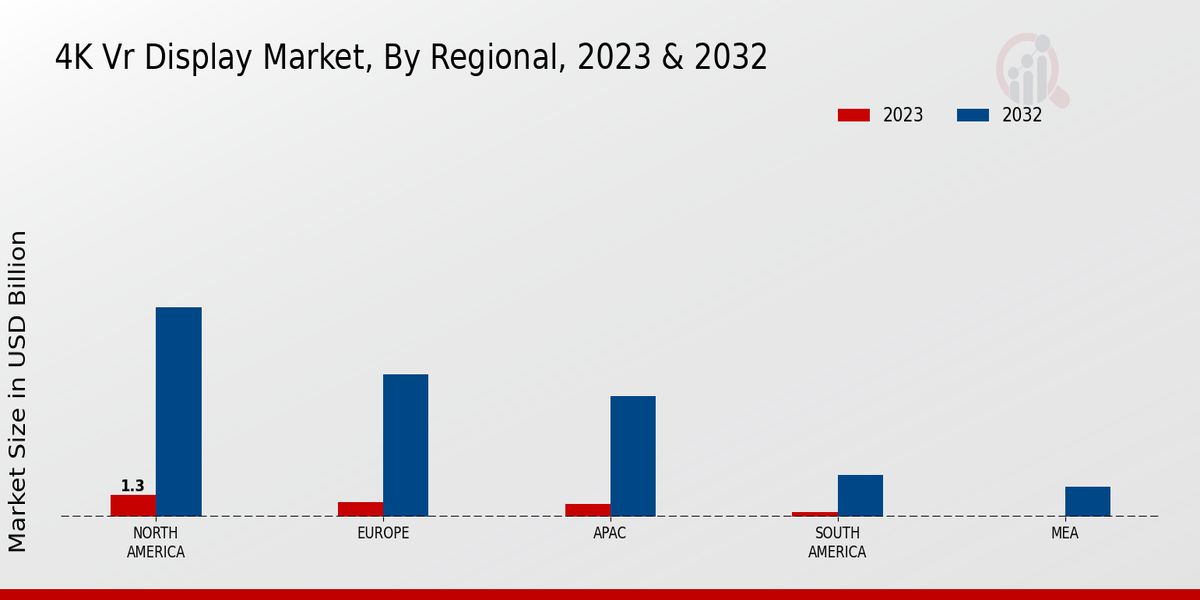Market Growth Projections
The Global 4K VR Display Market Industry is poised for substantial growth, with projections indicating a market value of 5.33 USD Billion in 2024 and an anticipated increase to 82.5 USD Billion by 2035. This remarkable growth trajectory reflects the increasing integration of VR technology across various sectors, including gaming, education, and entertainment. The expected CAGR of 28.28% from 2025 to 2035 underscores the potential for innovation and expansion within the industry. As consumer demand for immersive experiences continues to rise, the market is likely to evolve, presenting new opportunities for stakeholders.
Expansion of VR Content Libraries
The expansion of VR content libraries significantly influences the Global 4K VR Display Market Industry. As more developers create high-quality content tailored for VR platforms, the appeal of 4K VR displays increases among consumers. This growth in content availability encourages users to invest in VR hardware, thereby driving sales in the market. Major gaming companies and content creators are actively producing VR experiences that leverage the capabilities of 4K displays, further solidifying the market's trajectory. With projections indicating a market value of 82.5 USD Billion by 2035, the continuous influx of diverse content is likely to sustain this upward momentum.
Rising Demand for Immersive Experiences
The Global 4K VR Display Market Industry experiences a surge in demand for immersive experiences across various sectors, including gaming, education, and healthcare. As consumers increasingly seek high-quality visual experiences, the adoption of 4K VR displays becomes more prevalent. For instance, the gaming industry alone is projected to contribute significantly to this growth, with an estimated market value of 5.33 USD Billion in 2024. This trend indicates a broader acceptance of VR technology, suggesting that immersive experiences are not merely a novelty but a fundamental shift in how content is consumed and interacted with.
Increased Adoption in Education and Training
The Global 4K VR Display Market Industry sees increased adoption in educational and training applications, where immersive learning experiences enhance engagement and retention. Institutions are leveraging VR technology to create realistic simulations that allow students to practice skills in a safe environment. For example, medical schools utilize VR displays to train students in surgical procedures, providing a hands-on experience without the risks associated with real-life practice. This trend not only improves educational outcomes but also drives market growth, as educational institutions recognize the value of investing in advanced technologies to prepare students for future challenges.
Growing Interest from the Entertainment Sector
The Global 4K VR Display Market Industry benefits from growing interest in virtual reality within the entertainment sector. As filmmakers and content creators explore new storytelling techniques, VR technology offers unique opportunities to engage audiences in unprecedented ways. High-definition 4K displays enhance the visual experience, making it more immersive and captivating. Events such as virtual concerts and interactive films are becoming increasingly popular, attracting a wider audience. This trend suggests that the entertainment industry is not only adopting VR technology but is also investing in it, thereby contributing to the overall growth of the market.
Technological Advancements in Display Technology
Technological advancements play a crucial role in driving the Global 4K VR Display Market Industry. Innovations in display technology, such as improved refresh rates, enhanced color accuracy, and reduced latency, contribute to a more realistic and engaging user experience. Manufacturers are investing heavily in research and development to create displays that not only meet but exceed consumer expectations. As a result, the market is likely to witness a compound annual growth rate (CAGR) of 28.28% from 2025 to 2035. This growth is indicative of the industry's commitment to pushing the boundaries of what is possible in virtual reality.






















Leave a Comment